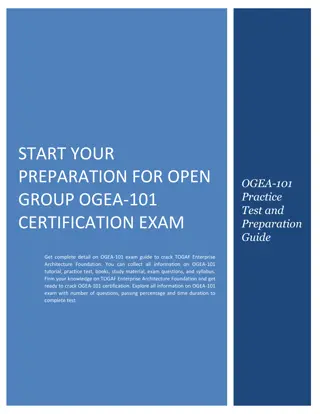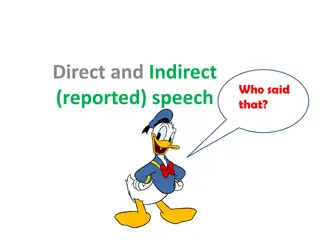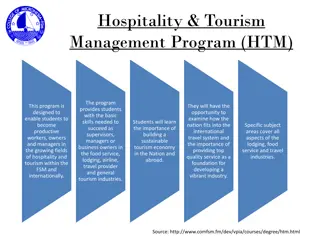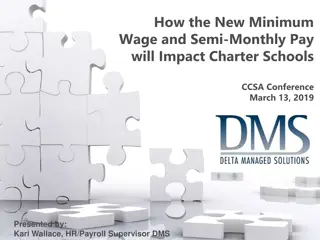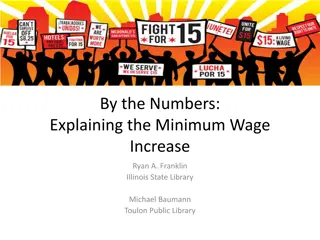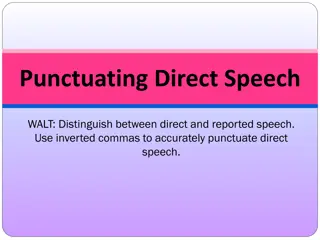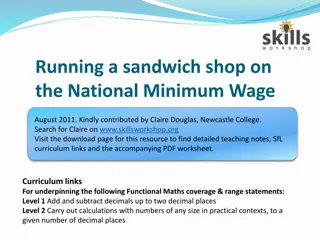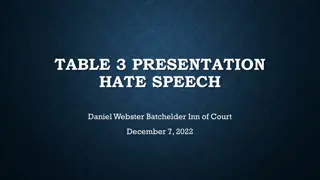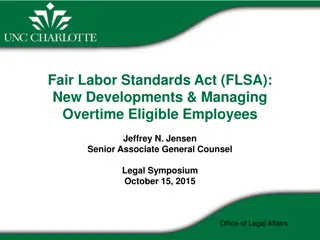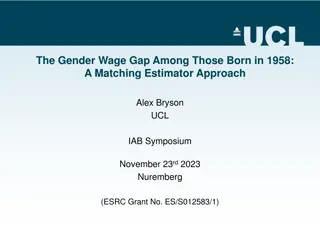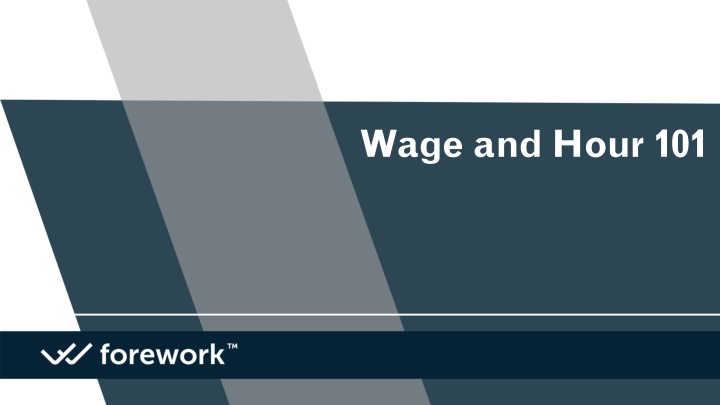
Wage and Hour Laws for Hospitality Employers
Learn about the federal Fair Labor Standards Act and New York Labor Law regulations that govern how employees in the hospitality industry are compensated. Explore minimum wage requirements, classifications of employees, tip credits, and more to ensure compliance with the law.
Download Presentation

Please find below an Image/Link to download the presentation.
The content on the website is provided AS IS for your information and personal use only. It may not be sold, licensed, or shared on other websites without obtaining consent from the author. If you encounter any issues during the download, it is possible that the publisher has removed the file from their server.
You are allowed to download the files provided on this website for personal or commercial use, subject to the condition that they are used lawfully. All files are the property of their respective owners.
The content on the website is provided AS IS for your information and personal use only. It may not be sold, licensed, or shared on other websites without obtaining consent from the author.
E N D
Presentation Transcript
Applicable Laws The federal Fair Labor Standards Act and the New York Labor Law are the laws that dictate how employees are paid. Each of these laws also has regulations that further elaborate on the laws requirements. In 2010, New York DOL created the Hospitality Industry Minimum Wage Order (i.e., the regulations) by combining the regular Minimum Wage Orders covering the Restaurant Industry and the Hotel Industry into one comprehensive Wage Order. The Hospitality Wage Order made significant changes to how employees in the hospitality industry must be compensated and the records hospitality employers must maintain. The Hospitality Wage Order contains the regulations for Fast Food Workers
Minimum Wage Hospitality Employer: Any hotel or restaurant Covered Employees: Service Employees -An employee who customarily receives tips at or above the Tip Threshold, but who is not a food service worker or Fast-Food Employee. Food Service Worker an employee who (a) is primarily engaged in the serving of food or beverages to guests; and (b) regularly receives tips from such guests. Non-Service Employees- any employee who is neither a Food Service Worker nor a Service Employee Fast Food Employee - Any person employed or permitted to work at or for a Fast- Food Establishment by any employer where such person s job duties include at least one of the following: customer service, cooking, food or drink preparation, delivery, security, stocking supplies or equipment, cleaning, or routine maintenance. **Determining whether a worker is a Service Employee or a Non-Service Employee must be made on a weekly basis, but no worker may be classified as a Service Employee on any day where he or she has been assigned to work in an occupation in which tips are not customarily received for 2 hours or more or for more than 20% of his or her shift, whichever is less. Exempt Employees: Individuals exempt from overtime requirements
Minimum Wage The minimum wage must be paid per hour of work, up to 40 hours/week, based on the location of the employee s work (not their residence) and, for some New York City establishments, the rate of minimum wage depends on the number of employees employed by the establishment. Location Minimum Wage New York City $15.00 Rest of NYS $14.20 Fast Food Workers (all of New York State) $15.00
Tip Credit Under limited and specific circumstances, employers in the hospitality industry may be able to reduce their minimum wage obligation for their Food Service or Service Employees (but not Fast-Food Workers) by taking a tip credit. The employer uses a portion of the employee s tips to count towards the minimum wage and, therefore, the employer pays the employee a lower cash wage. But, if the employee s cash wage and tips do not total up to at least minimum wage per hour, for all hours worked, the employer must make up the difference. Also, for some employees, New York Law requires that, in order for the employer to even take a tip credit, a tip threshold be met. A tip threshold is the minimum amount of cash that an employee must earn in tips per hour. The DOL establishes the amount of the tip threshold and employers bear the burden of proving the tip threshold was met.
Loss of Tip Credit A hospitality industry employer may not take a tip credit against its minimum wage obligations for a Food Service Worker or a Service Employee on any day where he or she works in a non-tipped occupation for the lesser of: 2 hours or more; or more than 20% of his or her shift.
Taxability of Tips From the IRS s standpoint, tips mean: Cash tips received directly from customers (including any credit card tips or tips received under tip- sharing arrangements) Tips from customers who leave a tip through electronic settlement or payment. This includes a credit card, debit card, gift card or any other electronic payment method. The value of any noncash tips, such as tickets or other items of value. Tip amounts received from other employees paid out through tip pools, tip splitting, or other formal/informal tip sharing arrangement. All cash and non-cash tips an received by an employee are income and are subject to Federal income taxes. All cash tips received by an employee in any calendar month are subject to social security and Medicare taxes. If the total tips received by the employee during a single calendar month by a single employer are less than $20, then these tips are not required to be reported and taxes are not required to be withheld.
Overtime Under federal and New York law, non-exempt employees must receive overtime pay for all hours worked above 40 per week. Employees who are exempt are exempt from this overtime requirement. This presentation will cover the most common overtime exemptions later in the presentation. Most employees are entitled to overtime. Any overtime that is owed must be paid at the same time that the employee s regular wages for the week at issue are paid.
Calculating Overtime Overtime is computed as 1.5 times the employee s regular rate of pay. The regular rate of pay may be different from week to week. If the employee is paid one single rate for all work hours, then the regular rate computation is straightforward. But if the employee has multiple jobs and rates for those jobs during a single week, the regular rate must be computed each week before the overtime premium can be calculated.
Overtime Calculation Example Employee works a total of 49 hours in a single week. In job A, the employee is paid $15.00/hour. In job B, the employee is paid at $19.00/hour. The employee worked a total of 23.5 hours in Job A, and 25.5 hours in Job B. The steps that underlie your payroll process for this employee s overtime calculation are as follows: Add up the gross calculation for all the hours by multiplying the number of hours the employee worked in both jobs, at both rates. Thus, the employer must calculate: Job A rate of $15 x 23.5 hours (for total wages of $352.50) with Job B rate of $19 x 25.5 hours (for total rate of $484.5). The total compensation at these rates is $484.5 +352.50 = $837 To calculate the regular rate, divide the total compensation of $837 by the total hours worked that week (which is 23.5 in Job A + 25.5 in Job B = 49). This yields an average rate of $17.08, and this is the regular rate. The overtime premium is computed by multiplying the regular rate by one-half times. The regular rate is only multiplied by .5 rather than 1.5 because the full-time rate has already been paid to the employee (for Jobs A and B) and, thus, only the .5 of the overtime rate remains to be paid.
Overtime Example, Cont. To calculate the .5, the average rate of $17.08 x 0.5 = $8.54. So, the overtime premium, to be paid for the overtime hours, is $8.54/hour. To calculate the total owed for overtime in this example, multiple $8.54 x 9 hours of overtime = $76.86. Thus, $76.86 (for the overtime hours) must be paid on top of the total aggregate compensation of $837. The total weekly compensation for the employee is $913.86 for the 49 hours of work at 2 different rates of pay.
Overtime and Tip Credits For employers who take a tip credit towards their minimum wage obligations cannot first subtract the tip credit and then compute the overtime premium. Instead, the overtime rate is computed based on the employee s regular rate (prior to the subtraction of a tip credit), multiplied by 1.5, minus the tip credit, as follows: An employer in NYC that takes a tip credit of $5.00 for an employee who has worked 43 hours during the week and earned $700 in tips will compute the overtime as follows: ($15 hourly rate x 1.5 x 3 OT hours) - (3 OT hours x $5 tip credit) =$52.50
Rate of Pay Forms The Wage Theft Prevention Act requires that, at the time of hire and before any change in the required notices, an employer provide the employee with a wage notice form, in English and the employee s primary language (if different than English) that contains the following information: Name of employer and any DBA The physical address of the employer s main office or principal place of business and mailing address if different Telephone # of employer Rate or rates of pay for the employee and basis of (e.g., weekly, salary, hourly) Allowances (e.g., tip credits, lodging) The regular pay day designated by the employer
Tip Pooling and Tip Credit Agreements If an employer requires its food service employees to pool their tips, then the employer should have an agreement or other document that the employee signs detailing how the tip pool operates, including how each individual employee s share of the tip pool is calculated. For employers that take tip credits, the following statement must be included in the Rate of Pay form, a tip pooling agreement, or the employee handbook, but the employee must acknowledge the statement: If you do not receive enough tips over the course of a week to bring you up to the minimum hourly rates of $____ per hour for the first 40 hours and $_____ per hour for hours over 40, you will be paid additional wages that week to make up the difference.
Uniforms If an employer mandates that an employee wear a Required Uniform, it must reimburse the employee the total cost of purchasing enough uniforms for an average workweek by the next pay day. To determine if the clothing is a required uniform subject to the Wage Order, employers should evaluate whether the clothing that employees wear at work is (a) required by the employer or (b) required to be worn in order to comply with any law, rule or regulation. Clothing that may be worn as part of an employee s ordinary wardrobe is not considered a required uniform. Ordinary wardrobe means ordinary basic street clothing selected by the employee where the employer permits variations in the details of dress. Employers may not avoid the obligation to reimburse an employee s cost in purchasing Required Uniforms by requiring individuals to purchase such Required Uniforms prior to beginning employment. No Offsets/No Phase Outs: The Required Uniform reimbursement may not be offset by any credits for meals or lodging provided by the employer, and it must be paid regardless of the employee s regular wage rate.
Uniform Maintenance If an employer mandates that employees wear a Required Uniform, the employer must: (i) maintain the uniform; or (ii) provide uniform maintenance pay to that employee. 1. Maintaining Uniforms: Maintaining Required Uniforms includes washing, ironing, dry cleaning, making alterations, repairing, or performing any other maintenance necessary at no cost to the employee. 2. Employee Opt-Out Exception: An employer is not required to pay uniform maintenance pay to an employee who chooses not to use its laundry service where the employer: a. Launders required uniforms free of charge and with reasonable frequency; b. Ensures the availability of an adequate supply of clean, properly-fitting uniforms; and c. Informs employees individually in writing of such service.
Spread of Hours The spread is the period between when the employee commences work at the start of the day until the employee finishes work at the end of the day, inclusive of all breaks, whether paid or unpaid. In New York, if an employee s spread of hours on any given day is greater than ten (10), the employee is entitled to one hour of pay paid at the applicable minimum wage rate even if the employee s regular hourly wage is greater than the minimum wage. Notably, the spread can occur if the employee works two shifts in a single day and the spread between the beginning and end of their workday exceeds 10 hours, OR if the employee works a shift longer than 10 hours. If an employer takes a tip credit towards its minimum wage obligations for an employee and that employee is entitled to a spread of hours payment, the payment is made at the regular minimum wage applicable to the employee and not at the cash wage paid to the employee. Overtime exempt employees are not entitled to spread of hours payments when they work a spread of hours of more than ten (10) on a given day.
Split Shift Pay Employees are entitled to one (1) additional hour of pay at the minimum wage rate for any day where the working hours are not consecutive. Working hours are not considered consecutive where there is an intervening period of more than one (1) hour during the workday.
Call-In Pay For any shift, outside of a regularly scheduled shift, employees must receive minimum wage pay as set forth below. Call-In Pay Obligation: Any employee who reports for duty on any day at the request or permission of the employer must be paid at the applicable wage rate for at least: (1)3 hours for 1 shift; (2)6 hours for 2 shifts totaling 6 hours of less; and (3)8 hours for 3 shifts totaling 8 hours or less. An employee is entitled to call-in pay even when he or she did not remain at work for this period of time and/or was not assigned any actual work. The term applicable wage rate means: (1) payment for time of actual attendance calculated at the employee s customary rate of pay, minus any customary and usual tip credit; and (2) payment for the balance of the period calculated at the basic minimum hourly rate with no tip credit subtracted.
White Collar Exemptions Generally, all employees are eligible for overtime pay for overtime hours/work, UNLESS an exemption applies. Exemptions are limited. Employees are exempt from overtime obligations if: (1) they are paid on a salary basis; (2) receive a predetermined minimum salary amount, as required by NYS law; and (3) their primary duty involves performance of one of the exempt duties. Being paid on a salary basis means an employee regularly receives a predetermined amount of compensation each pay period on a weekly, or less frequent, basis. The predetermined amount cannot be reduced because of variations in the quality or quantity of the employee s work. Subject to certain exceptions, an exempt employee must receive the full salary for any week in which the employee performs any work, regardless of the number of days or hours worked.
White Collar Exemptions, Cont. Most Common Exemptions Professional Exemption The employee s primary duty must be either (a) the performance of work requiring advanced knowledge (which is work that is predominantly intellectual in character and includes the consistent exercise of discretion and judgment) in a field of science or learning customarily acquired by a prolonged course of specialized intellectual instruction or (b) Original and creative in character in a recognized field of artistic endeavor (as opposed to work which can be produced by a person endowed with general manual or intellectual ability and training) and the result of which depends primarily on the invention, imagination or talent of the employee. Administrative Exemption The employee s primary duty must be the performance of office or non-manual work that is directly related to the management or general business operations of the employer or the employer s customers and the employee s primary duty must include the exercise of discretion and independent judgment with respect to matters of significance. Executive Exemption The employee s primary duty must be management of the enterprise or a customarily recognized department or subdivision thereof, the employee must customarily and regularly direct the work of 2 or more full-time employees (or their equivalents), and the employee must have the authority to hire or fire other employees, or to make suggestions or recommendations that are given particular weight as to the hiring, firing, advancement, promotion, or other change in status of other employees.
Independent Contractors and Worker Misclassification The U.S. Supreme Court has on a number of occasions indicated that there is no single rule or test for determining whether an individual is an independent contractor or an employee for purposes of the FLSA. The Court has held that it is the total activity or situation which controls. Among the factors which the Court has considered significant are: 1.The extent to which the services rendered are an integral part of the principal's business. 2.The permanency of the relationship. 3.The amount of the alleged contractor's investment in facilities and equipment. 4.The nature and degree of control by the principal. 5.The alleged contractor's opportunities for profit and loss. 6.The amount of initiative, judgment, or foresight in open market competition with others required for the success of the claimed independent contractor. 7.The degree of independent business organization and operation.






